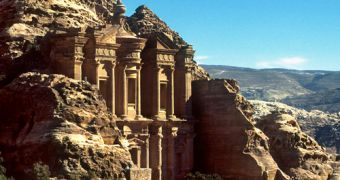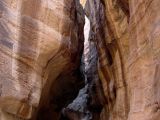Ancient cities were usually located on main rivers whose waters were a source of food and sometimes protection. But on the northwestern extremity of the Arabian Desert there was a city renowned for its lack of water: Petra. In the arid areas of the Middle East the caravan routes connected cities located at great distances from each other. But camels, despite their extraordinary resistance, require halts for drinking. 2,000 years ago, Petra was one of the most famous pit stops.
Petra was located at the cross of two great trade routes: one connecting Red Sea to Damascus and the other connecting Persian Gulf to Gaza, on the Mediterranean shore. Caravans coming from the gulf, charged with spices, had to confront the harsh Arabian Desert for weeks before entering at Wadi Mousa the narrow and cool canyon (called Siq and being 1 km (0.6 mi) long and over 100 m (330 ft) tall), representing the entrance to Petra and its natural defense. Here they could find food, shelter, and above all, the refreshing cold water.
In exchange, the caravans had to offer gifts to the guards, doormen and servants of the Petra's king, aside from what had to be paid for forage and shelter. But the enormous sums gained from spice and perfume trade in the European cities fueled the caravan flow that enriched Petra.
Petra was founded by the Nabatheans, an ancient Arab tribe, five centuries before Christ, to know its peak time between 169 BC and 106 AD, when the city was conquered by the armies of the Roman emperor Trajan. The Nabathean king Arethas IV Philopatris (9 BC to 40 AD) enriched the city with numerous monuments that still stand.
In Petra, the rainfall is just 150 mm annually and there's no spring or well. To get the precious water, Petra's inhabitants carved into the massive rocks channels, basins and reservoirs. Each droplet of rain was collected and preserved. The ability to preserve water enabled the ancient inhabitants of Petra to cultivate land, keep animals and build a commercial center whose traders enriched due to the commerce with frankincense and myrrh. A sinuous channel still transports water in the Siq.
Petra's inhabitants were also famous builders. "Petra" means "rocky mass" and Petra was indeed built on stone. The Nabatheans carved patiently directly in the massive rock the houses, the high tombs and temples. The mountains of red sandstone in which the city was built allowed this work and in the first century AD Petra was a mighty city in the middle of the desert, located on a vast natural amphitheater of sandstone.
But when Romans found sea ways to the Orient, the land spice trade plummeted and Petra was left to the desert. But its buildings did not disappear and today 500,000 people visit the place. There is even a still standing 2nd century Roman amphitheater, with a capacity of 3,000 seats, carved in the same Nabathean style in the rock. In the ancient city's streets the access of cars is forbidden, and non-pedestrian visitors can see it only on camel, horse or donkey.
The most famous building of Petra is Ed Deir or "The Monastery", 50 m (166 ft) wide and 45 m (150 ft) tall, supposed to have been initially a temple carved during the 3rd century which served as Christian Church, as indicated by the crosses carved in the rock. The most beautiful building of Petra is Al Khazneh, with its rock carved columns and laces, which turn pink in the sunlight.

 14 DAY TRIAL //
14 DAY TRIAL // 
